Perhaps the most striking feature of the Tirthaji system is its coherence. The whole system is interrelated and unified: the general multiplication method, for example, is easily reversed to allow one-line divisions, and the simple squaring method can be reversed to give one-line square roots. And, these are all easily understood. This unifying quality is very satisfying, it makes arithmetic easy and enjoyable, and it encourages innovation.
Difficult arithmetic problems and huge sums can often be solved immediately by Tirthaji's methods. These striking and beautiful methods are a part of a system of arithmetic which Tirthaji claims to be far more methodical than the modern system. "Vedic" Mathematics is said to manifest the coherent and unified structure of arithmetic, and its methods are complementary, direct and easy.
The simplicity of the Tirthaji system means that calculations can be carried out mentally, though the methods can also be written down. There are many advantages in using a flexible, mental system. Pupils can invent their own methods; they are not limited to one method. This leads to more creative, interested and intelligent pupils.
Interest in the Tirthaji's system is growing in education, where mathematics teachers are looking for something better and finding the Vedic system is the answer. Research is being carried out in many areas including the effects learning the Tirthaji system has on children; developing new, powerful but easy applications of these Sutras in arithmetic and algebra.
The real beauty and effectiveness of the Tirthaji system cannot be fully appreciated without practising the system. One can then see why its enthusiasts claim that it is the most refined and efficient calculating system known.
"Vedic Mathematics" refers to a technique of calculation based on a set of 16 Sutras, or aphorisms, as algorithms and their upa-sutras or corollaries derived from these Sutras. Its enthusiasts advance the claim that any mathematical problem can be solved mentally with these sutras.





